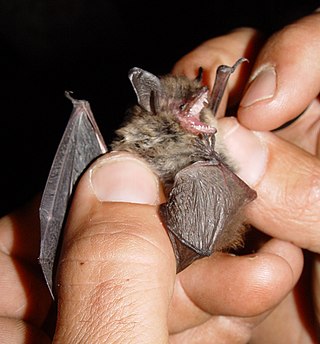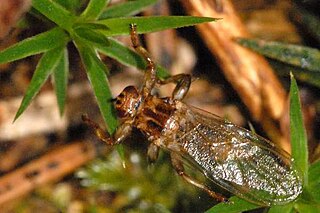
Rissooidea, originally named Rissoacea by Gray, 1847, is a taxonomic superfamily of small and minute marine snails, belonging to the clade Littorinimorpha.

The mouse-eared bats or myotises are a diverse and widespread genus (Myotis) of bats within the family Vespertilionidae. The noun "myotis" itself is a Neo-Latin construction, from the Greek "muós and "oûs", literally translating to "mouse-eared".

Nycteribiidae is a family of the true fly superfamily Hippoboscoidea are known as "bat flies", together with their close relatives the Streblidae. As the latter do not seem to be a monophyletic group, it is conceivable that bat flies cannot be united into a single family.

Mesostigmata is an order of mites belonging to the Parasitiformes. They are by far the largest group of Parasitiformes, with over 8,000 species in 130 families. Mesostigmata includes parasitic as well as free-living and predatory forms. They can be recognized by the single pair of spiracles positioned laterally on the body.

The thorny-headed worm family Polymorphidae contains endoparasites which as adults feed mainly in fish and aquatic birds. When this taxon was erected by Meyer in 1931, a subfamily Polymorphinae was established in it. As the Polymorphidae as presently understood would then be monotypic, with no basal genera outside the Polymorphinae, the proposed subfamily is redundant for the time being and therefore most modern treatments simply omit it. Polymorphus minutus is an economically significant parasite in goose and duck farming.

Ornithomya are genus of biting flies in the family of louse flies, Hippoboscidae. There are 29 known species. All species are parasites of birds.

Isoperla is a genus of Palaearctic and Nearctic stoneflies in the subfamily Isoperlinae and the family Perlodidae.

Androlaelaps is a genus of mites in the family Laelapidae.
The Macronyssidae are a family of parasitic mites in the order Mesostigmata.

The Laelapidae are a family of mites in the order Mesostigmata. The family is also referred to in the literature as Laelaptidae, which may be the correct spelling.

Dermanyssidae is a family of mites in the order Mesostigmata.

Ptilonyssus is a genus of mites in the family Rhinonyssidae. There are at least 230 described species in Ptilonyssus.

Tinaminyssus is a genus of mites in the family Rhinonyssidae. There are more than 60 described species in Tinaminyssus.

Spinturnicidae is a family of mites in the order Mesostigmata. The mites are highly specialized parasites of wing or tail membrane or bats. Some species infest eyelids and eye canthi. The species of Spinturnicidae are found in bat habitats throughout the world, living all stages of life on bats.
Ancystropus is a genus of mites in the family Spinturnicidae. There are about seven described species in Ancystropus, found in Asia, the Middle East, Africa, and South Pacific islands.
Meristaspis is a genus of mites in the family Spinturnicidae. There are about six described species in Meristaspis, found in Asia, Africa, the Middle East, Australia, and the Pacific islands.
Mesoperiglischrus is a genus of mites in the family Spinturnicidae. There are at least two described species in Mesoperiglischrus, found in the Neotropics.

Spinturnix is a genus of mites in the family Spinturnicidae. Spinturnix mites are an ectoparasite found on species of bats. They live exclusively on the wing and tail membranes and are large enough to be seen with the naked eye. Spinturnix mites are a host specific species, meaning they have a few major host species that they prefer, as well as a few less frequently used hosts. In short, these mites will not infect arbitrary bat species. Their selection of host tends to align with the host species that lives closest to their local environment. Spinturnix mites are found strictly on Microchiroptera. These mites are hematophagous, meaning they feed on the blood of their host. They cannot survive without a host for more than a few hours. Therefore, transmission of mites to other hosts must occur by close contact, such as a bat in a roost.
Cameronieta is a genus of mites in the family Spinturnicidae. There are about seven described species in Cameronieta, found in the Neotropics and Caribbean islands.












